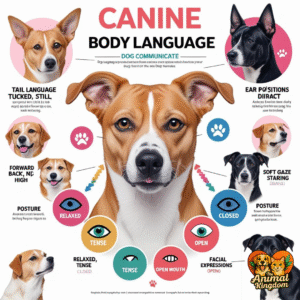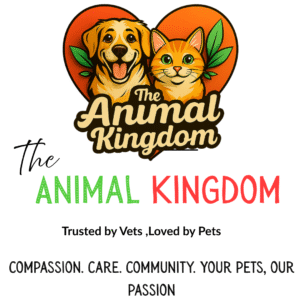
🐾 What Is Your Dog Trying to Tell You? A Real Guide to Dog Body Language
The Day I Almost Missed the Warning Signs
I’ll never forget the backyard BBQ where my friend’s golden retriever, Max, “suddenly snapped” at a toddler.
Everyone was shocked. “He’s so sweet!” they said. “He was wagging his tail!”
But looking back? Max had been screaming “I’m overwhelmed!” for 20 minutes.
His tail was stiff and high—not loose and wiggly.
His ears were pinned back.
He kept turning his head away, licking his lips, and freezing when kids got too close.
We just didn’t know how to listen.
That moment changed everything for me. I dove into canine communication—not as a scientist, but as a dog lover who never wanted to miss those quiet pleas again.
Turns out, dogs are talking to us all the time. We just need to learn their language.
It’s Not Just the Tail: The Full Picture Matters
Forget the myth: a wagging tail doesn’t always mean happy.
A growl doesn’t always mean aggressive.
And “guilty eyes”? That’s fear—not remorse.
Dogs communicate with their whole body. To understand them, you need to read the entire scene:
✅ Relaxed & Happy
- Loose, wiggly body
- Tail at neutral height, wagging side-to-side (not stiff!)
- Soft eyes, slightly squinty
- Ears relaxed, mouth maybe slightly open (like a “dog smile”)
👉 This is your dog saying, “All is well.”
⚠️ Stressed or Anxious
- Lip licking (even with no food around)
- Yawning (not sleepy—nervous!)
- Whale eye (showing the whites of their eyes)
- Tail low or tucked, ears back
- Freezing (sudden stillness = “I’m scared and deciding what to do”)
👉 This is your dog saying, “I’m uncomfortable. Please help.”
❗ Fearful or Defensive
- Crouched low, tail tucked tightly
- Ears flat against head
- Hackles raised (fur along spine standing up)
- Growling or snapping (a last resort—they’ve already asked you to back off!)
👉 This is your dog saying, “I feel trapped. I need space—now.”
💥 Confident or Aggressive
- Stiff, tall posture
- Tail high and rigid (not wagging loosely)
- Ears forward, intense stare
- Lips curled, showing teeth
👉 This is your dog saying, “Back off—or else.”
🐾 Key insight: The same behavior (like growling) can mean play (if body is loose, tail wiggly) or warning (if body is stiff, eyes hard). Context is everything.
Common Signals We Get Wrong (And What They Really Mean)
❌ “My dog feels guilty when I come home to a mess.”
✅ Truth: That “guilty look” is fear of your reaction—not remorse. Dogs live in the moment. They don’t connect your anger to something they did 3 hours ago.
❌ “Tail wag = happy!”
✅ Truth: A fast, stiff wag held high often means arousal or tension—not joy. A loose, sweeping wag at mid-height? That’s the happy one.
❌ “Growling is bad—I should stop it.”
✅ Truth: Growling is a gift. It’s your dog’s way of saying, “I’m at my limit.” Punish it, and you may get a bite without warning next time.
❌ “My dog loves hugs!”
✅ Truth: Most dogs tolerate hugs—they don’t enjoy them. Watch for lip licks, head turns, or stiffening. A side-by-side lean? That’s real affection.
How Environment Changes Everything
Your dog’s body language shifts based on where they are and who’s around:
- At the vet: Even confident dogs may cower, pant, or hide. That’s normal—not “bad behavior.”
- At the dog park: A play bow (front down, rear up) means “Let’s play!” But if one dog ignores the other’s “stop” signals (like turning away or growling), step in.
- At home with guests: Lip licking, yawning, or hiding under the bed? Your dog isn’t “rude”—they’re overwhelmed. Give them an escape route.
🌟 Pro tip: Create a “safe zone” (like a crate or quiet room) where your dog can retreat without being followed. Respect it—and teach kids to do the same.
Talk Back: How to Respond the Right Way
When your dog speaks, listen—and respond kindly:
- See stress signals? → Remove them from the situation. Don’t force interaction.
- Hear a growl? → Say “Okay, good boy for telling me,” and give space. Never punish.
- Catch relaxed joy? → Gently praise or offer a treat. Reinforce calm confidence.
And use positive reinforcement to build trust:
- Reward calm behavior around triggers (like delivery people)
- Never scold for “guilt” or fear
- Let your dog say “no” (to pets, hugs, or strangers)
This isn’t just training—it’s respect.
The Gift of Understanding
Learning dog body language didn’t just make me a better pet parent—it saved friendships, prevented bites, and gave my dogs a voice.
Now, when my pup freezes at the sound of thunder, I don’t drag her outside “to toughen up.” I offer a quiet blanket fort.
When she growls at the vet tech, I say, “She’s nervous—can we go slower?”
And when she wags that loose, happy wag? I know, without a doubt, she feels safe.
That’s the real magic of this language: it turns guesswork into connection.
🐶 Want to become fluent in your dog’s silent language?
👉 Dive deeper with our complete visual guide to dog body language—including photos, real-life scenarios, and trainer tips:
Unlocking Canine Communication: A Comprehensive Guide to Dog Body Language
P.S. Download our free printable cheat sheet—“10 Body Language Cues Every Dog Owner Should Know”—when you visit the guide! Perfect for fridges, dog walkers, or nervous first-time owners.

